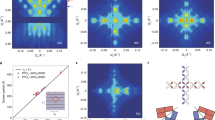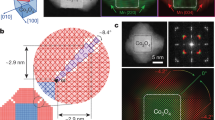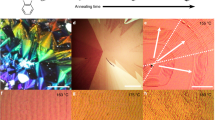Abstract
Patterning in nature typically occurs through self-organization, and interest has developed recently in the use of such spontaneous processes to fabricate periodically structured materials at the nanometre scale. For example, ordered arrays of semiconductor ‘quantum dot’ particles (superlattices) have been created by deposition from a suspension1, or by self-organization of diffusing atoms on surfaces2 or in sequentially grown stacked layers3. The spontaneous formation of layered structures in epitaxial growth has also been reported, and attributed to the process of spinodal decomposition4,5. Yet highly ordered layered superlattices, developed for applications in optoelectronics (and in future perhaps for thermoelectrics6), are created ‘by hand’ through the sequential deposition of two different materials. Here we show that superlattices can appear spontaneously during crystal growth of an alloy, as a consequence of the distribution of strain at surface step sites. When a strained alloy grows by ‘step flow’, the surface steps form periodic bunches7. We find that the resulting modulated strain field biases the incorporation of the respective alloy components at different steps in the bunch, leading to segregation and superlattice formation. We also present experimental observations (X-ray diffraction and electron microscopy) of a silicon–germanium alloy grown on silicon, which show clear evidence for the formation of such a self-organized structure.
This is a preview of subscription content, access via your institution
Access options
Subscribe to this journal
Receive 51 print issues and online access
$199.00 per year
only $3.90 per issue
Buy this article
- Purchase on Springer Link
- Instant access to full article PDF
Prices may be subject to local taxes which are calculated during checkout


Similar content being viewed by others
References
Murray, C. B., Kagan, C. R. & Bawendi, M. G. Self-organization of CdSe nanocrystallites into three-dimensional quantum dot superlattices. Science 270, 1335–1338 (1995).
Shchukin, V. A., Ledentsov, N. N., Kop'ev, P. S. & Bimberg, D. Spontaneous ordering of arrays of coherent strained islands. Phys. Rev. Lett. 75, 2968 (1995).
Tersoff, J., Teichert, C. & Lagally, M. G. Self-organization in growth of quantum dot superlattices. Phys. Rev. Lett. 76, 1675–1678 (1996).
Petroff, P. M., Cho, A. Y., Reinhart, F. K., Gossard, A. C. & Wiegmann, W. Alloy clustering in Ga1−xAlxAs compound semiconductors grown by molecular beam epitaxy. Phys. Rev. Lett. 48, 170–173 (1982).
Norman, A. G., Seong, T. Y., Fergunson, I. T., Booker, G. R. & Joyce, B. A. Structural studies of natural superlattices in group III-V alloy epitaxial layers. Semicond. Sci. Technol. 8, S9–S15 (1993).
Mahan, G. D. & Woods, L. M. Multilayer thermionic refrigeration. Phys. Rev. Lett. 80, 4016–4019 (1998).
Liu, F., Tersoff, J. & Lagally, M. G. Self-organization of steps in growth of strained films on vicinal substrates. Phys. Rev. Lett. 80, 1268–1271 (1998).
Tersoff, J., Phang, Y. H., Zhang, Z. & Lagally, M. G. Self-bunching instability of vicinal substrates under stress. Phys. Rev. Lett. 75, 2730–2733 (1995).
Tersoff, J. Stress-driven alloy decomposition during step-flow growth. Phys. Rev. Lett. 77, 2017–2020 (1996).
Venezuela, P. & Tersoff, J. Alloy decomposition during growth due to mobility differences. Phys. Rev. B 58, 10871–10874 (1998).
Guyer, J. E. & Voorhees, P. W. Morphological stability of alloy thin films. Phys. Rev. Lett. 74, 4031–4034 (1995).
Barabási, A. Self-organized superlattices formation in II–IV and III–V semiconductors. Appl. Phys. Lett. 70, 764–766 (1997).
Tersoff, J. Spinodal decomposition during step-flow growth. Phys. Rev. B 56, R4394–R4397 (1997).
Acknowledgements
P.V. was supported by the Brazilian agency FAPESP.
Author information
Authors and Affiliations
Corresponding author
Rights and permissions
About this article
Cite this article
Venezuela, P., Tersoff, J., Floro, J. et al. Self-organized growth of alloy superlattices. Nature 397, 678–681 (1999). https://doi.org/10.1038/17767
Received:
Accepted:
Issue Date:
DOI: https://doi.org/10.1038/17767
This article is cited by
Comments
By submitting a comment you agree to abide by our Terms and Community Guidelines. If you find something abusive or that does not comply with our terms or guidelines please flag it as inappropriate.



